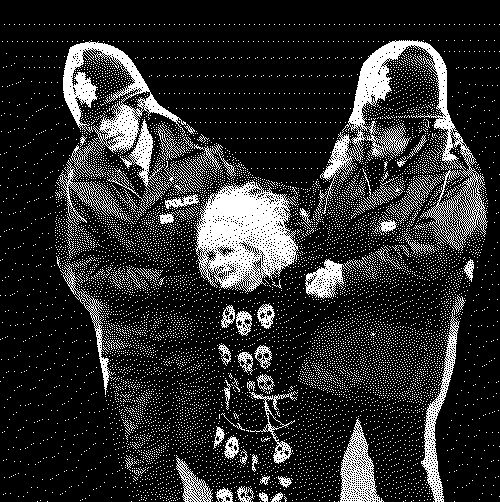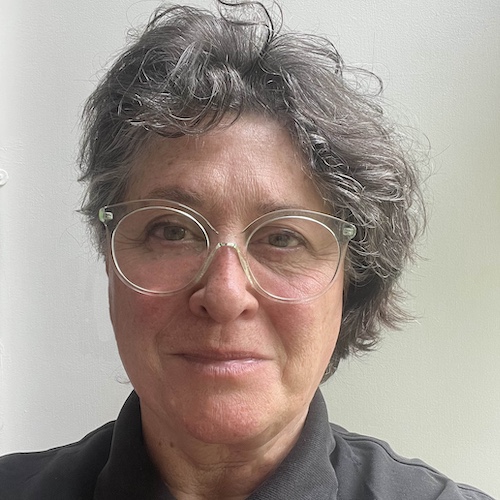Holes Big Enough for Women
Holes Big Enough for Women: Portals, Time Benders, and Queer Networks
By Liz Murray
'Zine
Artist’s Statement
In 1983 women from the Greenham Common Women’s Peace Camp made headlines when they protested from the roof of HM Prison Holloway. They had broken into the prison from outside in solidarity with fellow activists detained for “breach of the peace”. I remember the press coverage the following day describing the fence holes used to access the prison roof as being big enough for women, inadvertently suggesting a hole size through which men would not fit and capturing a subversive and deeply symbolic strategy: the creation and use of “portals” through restrictive patriarchal structures. These literal and metaphorical holes represent not only spaces of feminist resistance and ingenuity, but also entry points to an enduring legacy of queer activism that continues to challenge hegemonic systems today.
Though I was not among those who danced on the roof of Holloway prison, I was a frequent visitor to the peace camp at Greenham Common between 1982 and 1984, staying in a bender at Green Gate. For those unfamiliar with the term other than as a pejorative slur for homosexuals, benders were temporary shelters made from bending flexible tree branches, staking them to the ground, and covering them with polythene. These benders, constructed in part from earthly materials, were shaped by the politics of refusal and reflected the values of the peace camp: resilience, ecological awareness, and radical care.
At the time, I was also studying fine art at the Camberwell School of Arts and Crafts, navigating a deep cognitive and emotional dissonance between the painting studio and the looming spectre of nuclear war. Art school offered a space for experimentation and a lifeline out of the straightening forces of my conservative upbringing. Supported by my openly gay tutor Mario Dubsky, I was encouraged to reconcile my queer activist commitments with my creative practice. My drawings and paintings began to reflect the imagery and symbols of the peace camp: chain-link fences, spirals, webs, moons, and Wiccan iconography. These motifs were not simply aesthetic but were deeply political, functioning as visual codes within feminist and queer networks.
For this special issue of British Art Studies, I have created a 'zine in which I talk back to myself and reflect on the transnational queer networks formed during the 1980s anti-nuclear peace movement. Holes Big Enough for Women tells the lesser-known story of La Ragnatela (The Spider Web), a women-only encampment next to the NATO base in Comiso, Sicily.1 Like Greenham, it was founded on feminist principles of non-violence, communal living, and resistance, drawing on a transnational network of anti-nuclear activists for support. Unlike Greenham, it was not on common land and, to prevent the government from appropriating the site, over 4,000 women across Europe, including me, each purchased a single square metre of land symbolically for the accessible price of £2.50. Having multiple international owners mired the necessary legal process for the air base’s expansion in time-consuming and complex administration. It was a brilliant act of sabotage through legal means.
1These strategic interventions are the portals through which creativity, solidarity, and resistance travel. They embody the ethos of queer feminist activism: imaginative, disruptive, and rooted in care. The 'zine is more than an archive; it is a call to action. It invites a new generation of eco-fems, benders, and queers who don’t fit in to draw inspiration from past strategies of resistance. These herstories are important to remember but also to actively engage with and extend into the digital, social, and ecological terrains of today. As global politics becomes increasingly conservative, misogynistic, and hostile to diversity, we urgently need to devise contemporary portals for collective embodied dissent.
Acknowledgements
Thanks to Delma Hughes for refreshing memories and sharing stories about Greenham and La Ragnatela. My gratitude to the late queer activist and artist Andrew Lumsden, and the support extended to this project by his Grand Camp Maisie Fund. Thanks to the guest editors of the British Art Studies special issue “Queer Art in Britain since the 1980s”: Fiona Anderson, Flora Dunster, Theo Gordon, and Laura Guy, and to Baillie Card and Tom Powell on the journal’s editorial team. Finally, huge thanks to Nicky Coutts for design expertise, endless patience, and moral support when needed.
About the author
-
Liz Murray is an artist and academic who works with sculpture, photography, collage, and text. Her work addresses the ownership and celebration of queer, resistant, and radical histories, drawing on a personal archive of feminist and press materials from the 1980s. A former peace camp participant, Murray remains involved in different forms of socio-political activism and artivism, communicated most recently in her doctoral project “Performing Resistance: The Greenham Common Women’s Peace Camp as Artwork” (Royal College of Art, 2021). As a member of the Queer Materialities Research Network at Glasgow School of Art, Murray contributed to Queereal Secretions: Artistic Research as Exquisite Practice, edited by Nicky Coutts and Henry Rogers (Article Press, 2023). Solo exhibitions include Holes Big Enough for Women (Five Years, 2022) and backchat bender (Dyson Gallery, 2021). Other recent exhibitions and collaborations include NEON by GLAP Collective, a new sound work broadcast by On Air—On Site (The Hague, 2025), and Ad-Lib (XYZ Gallery, London, 2025). Her website is https://www.lizmurray.co.uk.
Footnotes
-
1
For background on the transnational feminist networks that established La Ragnatela, see Laura Branciforte, “The Women’s Peace Camp at Comiso, 1983: Transnational Feminism and the Anti-nuclear Movement”, Women’s History Review 31, no. 2 (2021): 316–43, DOI:10.1080/09612025.2021.1984026. ↩︎
Imprint
| Author | |
|---|---|
| Date | 14 July 2025 |
| Category | Artist Collaboration |
| Review status | Peer Reviewed (Editorial Group) |
| License | Creative Commons Attribution-NonCommercial 4.0 International (CC BY-NC 4.0) |
| Downloads | PDF format |
| Article DOI | https://doi.org/10.17658/issn.2058-5462/issue-27/lmurray |
| Cite as | Murray, Liz. “Holes Big Enough for Women: Portals, Time Benders, and Queer Networks.” In British Art Studies: Queer Art in Britain since the 1980s (Edited by Fiona Anderson, Flora Dunster, Theo Gordon and Laura Guy), by Fiona Anderson, Flora Dunster, Theo Gordon, and Laura Guy. London and New Haven: Paul Mellon Centre for Studies in British Art and Yale Center for British Art, 2025. https://doi.org/10.17658/issn.2058-5462/issue-27/lmurray. |
